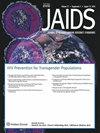肝脏脂肪变性与虚弱之间的关系因 HIV 血清状态而异。
IF 2.9
3区 医学
Q3 IMMUNOLOGY
JAIDS Journal of Acquired Immune Deficiency Syndromes
Pub Date : 2024-10-01
DOI:10.1097/qai.0000000000003477
引用次数: 0
摘要
背景虚弱与肥胖相关的并发症有关,但艾滋病毒感染者中的虚弱与非酒精性脂肪肝(NAFLD)之间的关系尚未得到完整描述。我们的目的是评估非酒精性脂肪肝与虚弱之间的关系。方法对多中心艾滋病队列研究中的男性进行横断面和纵向分析。非酒精性脂肪肝的定义是腹部计算机断层扫描中肝脏/脾脏比率<1.0;虚弱的定义是虚弱表型中的以下三项:虚弱、迟钝、体重减轻、疲惫和体力活动少。结果纳入了未感染艾滋病毒的男性(n = 200)和感染艾滋病毒的男性(n = 292)。非酒精性脂肪肝患病率分别为 21% 和 16%,虚弱率分别为 12% 和 17%。在患有非酒精性脂肪肝的男性中,身体虚弱在未感染艾滋病毒的男性中更为普遍(21% 对 11%)。在多变量分析中,在控制了重要变量后,非酒精性脂肪肝与体弱有显著相关性。与既未感染艾滋病毒也未患非酒精性脂肪肝的男性相比,既未感染艾滋病毒也未患非酒精性脂肪肝的男性出现虚弱的概率是后者的2.6倍[95% 置信区间(CI):1.2-至5.7]。感染艾滋病毒的男性则没有这种关联。未感染艾滋病病毒并患有非酒精性脂肪肝的男性出现虚弱的概率较高(27% vs 10%),但感染艾滋病病毒并患有非酒精性脂肪肝的男性出现虚弱的概率较低(14% vs 19%)。在纵向分析中没有发现明显的关系。结论 尽管在感染艾滋病毒的男性中虚弱的发生率增加,但在未感染艾滋病毒的男性中,非酒精性脂肪肝与虚弱有独立的相关性,而在感染艾滋病毒的男性中则没有。非酒精性脂肪肝的肌肉-肝脏-脂肪组织轴机制可能因艾滋病毒血清状况而异。本文章由计算机程序翻译,如有差异,请以英文原文为准。
Relationships Between Hepatic Steatosis and Frailty Differ by HIV Serostatus.
BACKGROUND
Frailty is associated with obesity-related comorbidities, but the relationship with nonalcoholic fatty liver disease (NAFLD) in people with HIV has been incompletely described. Our objective was to assess the associations between NAFLD and frailty.
METHODS
Cross-sectional and longitudinal analysis of men in the Multicenter AIDS Cohort Study. NAFLD was defined as a liver/spleen ratio <1.0 on abdominal computed tomography scans; frailty was defined by the frailty phenotype as having 3 of the following: weakness, slowness, weight loss, exhaustion, and low physical activity.
RESULTS
Men without (n = 200) and with HIV (n = 292) were included. NAFLD prevalence was 21% vs 16% and frailty 12% vs 17%, respectively. Among men with NAFLD, frailty was more prevalent in men without HIV (21% vs 11%). In multivariate analysis, NAFLD was significantly associated with frailty after controlling for significant variables. Men without HIV and NAFLD had 2.6 times higher probability [95% confidence interval (CI): 1.2- to 5.7] of frailty relative to men with neither HIV nor NAFLD. This association was not seen in men with HIV. The probability of frailty was higher among men without HIV with NAFLD (27% vs 10% in men without NAFLD) but lower among men with HIV with NAFLD (14% vs 19% in men without NAFLD). No significant relationships were found in longitudinal analyses.
CONCLUSIONS
NAFLD was independently associated with frailty among men without HIV but not men with HIV, despite increased prevalence of frailty among men with HIV. The mechanisms of the muscle-liver-adipose tissue axis underlying NAFLD might differ by HIV serostatus.
求助全文
通过发布文献求助,成功后即可免费获取论文全文。
去求助
来源期刊
CiteScore
5.80
自引率
5.60%
发文量
490
审稿时长
3-6 weeks
期刊介绍:
JAIDS: Journal of Acquired Immune Deficiency Syndromes seeks to end the HIV epidemic by presenting important new science across all disciplines that advance our understanding of the biology, treatment and prevention of HIV infection worldwide.
JAIDS: Journal of Acquired Immune Deficiency Syndromes is the trusted, interdisciplinary resource for HIV- and AIDS-related information with a strong focus on basic and translational science, clinical science, and epidemiology and prevention. Co-edited by the foremost leaders in clinical virology, molecular biology, and epidemiology, JAIDS publishes vital information on the advances in diagnosis and treatment of HIV infections, as well as the latest research in the development of therapeutics and vaccine approaches. This ground-breaking journal brings together rigorously peer-reviewed articles, reviews of current research, results of clinical trials, and epidemiologic reports from around the world.

 求助内容:
求助内容: 应助结果提醒方式:
应助结果提醒方式:


